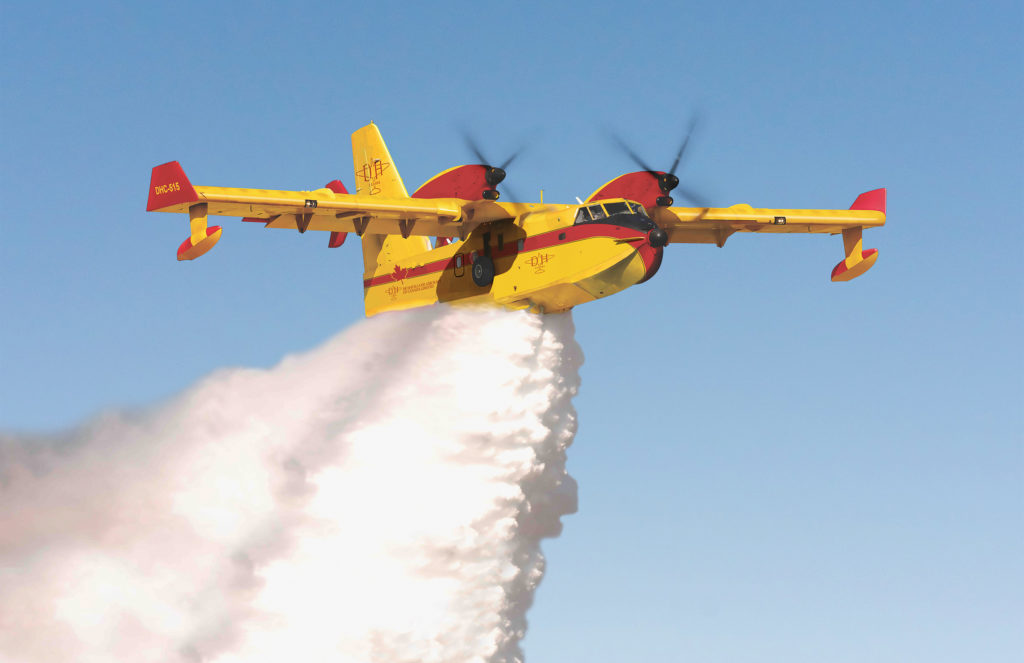Estimated reading time 4 minutes, 58 seconds.
Since announcing its DHC-515 Firefighter program last spring, De Havilland Aircraft of Canada Limited has been preparing to launch manufacturing for the new water bomber. While the production phase has not officially begun yet, the company has started manufacturing parts in Victoria, B.C., as part of the pre-production phase.
According to De Havilland’s vice-president of corporate affairs, Neil Sweeney, the company has “recently completed our Critical Design Review” with launch customers; “if contracts are completed in the near term, we can move . . . to the production phase before the end of the year,” he told Skies.
Victoria serves as the primary parts manufacturing location for the DHC-515 Firefighter, which was formerly known as the Canadair CL-515 program. De Havilland initially acquired the CL program back in 2016, and began considering a return to production in 2019.

The DHC-515 is based on the iconic CL-215 and -415 aircraft, but features upgrades to “increase functionality” – including “state-of-the-art navigational instruments”, as well as a high-lift wing and more efficient turboprop engines that burn 25 to 40 percent less fuel than jet engines. Both the wing and instant thrust of the engines allow for safer operations in mountainous terrain, and give the aircraft the ability to drop in close proximity to fires with accuracy.
Moreover, the aircraft is capable of delivering almost 700,000 litres of water per day, and can refill its tanks from fresh or saltwater in 12 seconds, as well as rough waters with waves up to two metres.
While parts are being manufactured in Victoria, Sweeney said final assembly will take place in Calgary at the company’s existing facilities. However, De Havilland is hoping to break ground on its massive new De Havilland Field site in Wheatland County, Alta., “early next year.” Once first buildings are operational – which Sweeney said could happen as soon as 2026 – final assembly of the DHC-515 Firefighter will be moved there.
Once the program has reached full production, De Havilland expects to have created roughly 650 direct jobs — “based primarily in Calgary, Victoria, and Toronto,” Sweeney said.
At the time of writing, De Havilland was discussing contracts for the potential acquisition of 22 DHC-515s. While over 60 percent of the existing Canadair fleet (CL-215 and -215T; CL-415 and -415EAF) is operating in Europe, it’s no surprise that all DHC-515 contract discussions are with “member states of the European Union,” noted Sweeney.
While the company has not yet received any orders from within Canada, Sweeney said “there is interest from provincial and territorial authorities.”
The current global fleet of CL-215 and CL-415 water bombers is aging. The former type was introduced some 50 years ago, and many of the planes have been put into retirement. The latter type was produced between 1993 and 2015, making the newest planes eight years old.
Firefighting aircraft continue to prove essential as wildfire seasons become more and more unpredictable. This year, Canada has experienced one of its worst wildfire seasons on record. As of Sept. 11, 2023, wildfires have been responsible for burning 17 million hectares across the country, according to the Canadian Interagency Forest Fire Centre.
De Havilland remains hopeful that contracts will be successfully completed before the end of this year, allowing production of the DHC-515 to begin. The first delivery is planned for the fire season of 2027, the company said.









This is good news.
Big freakin deal! They are kids toys compared to the Martin Mars that could deliver more than 3 times the amount of water per drop! This is all about “show”, not putting out wild fires!
The Canadian government needs to purchase 50 of these planes , I have watched them in action , awesome when they work as a team. Yes the Martin Mars are an amazing aircraft but to build them today cost would be astronomical. And because of water body size is not conducive to most fires. Canadian government wants away to reduce fires set up 10 -5 plane teams for the country, with what the provinces have would be a deciding factor in many fires.